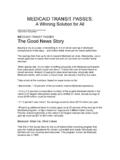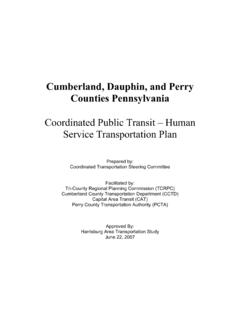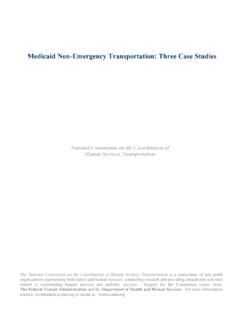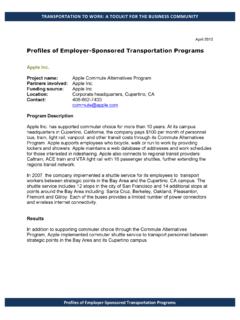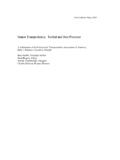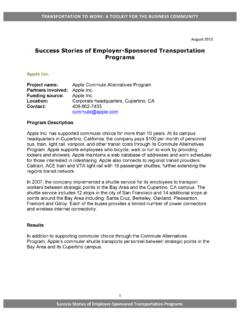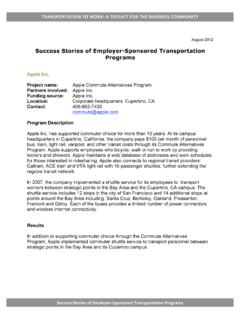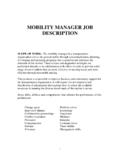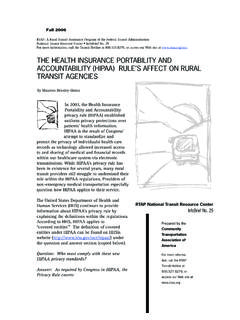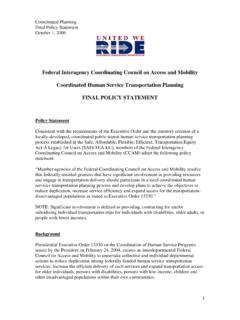Transcription of Rural Transit Performance Measurement - ctaa.org
1 Rural Transit Performance Measurement by Laurel J. Radow and Chris Winters Rural Transit systems have long sought ways to see how their services stack upto measure Performance . The typical method for this has been comparing ourselves to other systems or to ourselves over certain time periods. In the years ahead, as passengers expect more and funding continues to tighten and diversify, these measures will become increasingly important. Traditionally, Rural Transit systems have based their Performance measures on readily available data such as cost per mile or cost per trip.
2 Such assessment of daily operation efficiency, however, ignores Transit 's contributions to local, regional, state and national goals. For instance, at a time when Transit has been called upon to respond to national air quality goals, typical measurements such as passengers per vehicle mile do not explicitly tell how many people are taking the bus who would otherwise be driving and contributing to air pollution problems. It also does not portray the impact on business: without Transit 's part in cleaning up the air, a larger regulatory and tax burden would be placed on private industry.
3 Similarly, how does a Transit system work into its Performance the value of a person being able to receive dialysis treatment and hold a job? To demonstrate their value to the communities they serve, Rural Transit systems, especially those that provide coordinated service, often must use nontraditional Transit measures that incorporate such social values. Quality of life measurements, while difficult to calculate, can more accurately and persuasively track the level of care and benefit Transit provides to many who have no alternative.
4 Some nontraditional Transit measures, for example, calculate the number of people transported to meal sites to receive nutritious food, local residents who move from welfare to employment because of access to Transit or Transit users with improved health because of affordable, accessible transportation. While there are myriad Performance measures from which to choose, this brief provides a general overview of their use to help Rural Transit systems develop effective measures to improve productivity and quality of service. By helping systems pinpoint and use the most effective Performance measures, system officials can demonstrate that Transit is vital to the community.
5 For a comprehensive review of Performance measures, the details of obtaining them and pros and cons of different measures, we strongly recommend you obtain the Transit Cooperative Research Program (TCRP). Report 6, Users' Manual for Assessing Service-Delivery for Rural Passenger Transportation (see Annotated Resource List). Why Measure Performance ? There are as many reasons to measure Performance as there are aspects of your organization. For instance, you may need to: evaluate a contract provider to ensure competitive Performance ;. decide what service mode is better for a new area.
6 Reduce service but have many options as to where;. evaluate various expense categories as part of a budget-review process;. evaluate results from a previous service or operational change;. document the impact of service or its improvement as part of a funding arrangement; or convince decision makers that Transit service is a vital part of the community. While the term Performance Measurement sounds as if it were plucked from a management textbook, chances are that you already use Performance Measurement at least as part of your personnel practices.
7 When you give a skills test to competing job applicants, you are engaging in Performance Measurement . The same applies when you review your drivers' on-time, accident, complaint or maintenance records. In an organization as complex as a Transit system, there is an enormous variety of statistics from which to choose. It is crucial to pick the measurements based on your audience and what you are trying to say. For instance, if you receive urban Transit funding (Section 5307) from the Federal Transit Administration, you must fill out a series of reports known as the National Transit Database (Section 5335).
8 The Performance measures used for these forms can be quite different than those used to convince your local City Council and state representatives to fund operating costs for your system. And if you're undertaking a marketing campaign to convince the public of your timeliness and efficiency you might choose yet another set of measures. What to Measure? What you measure depends on what you want to find out. There are generally four ways to measure your Performance . While you are not limited to these ways, they outline a useful way of thinking about how your system performs and the different ways to capture its unique attributes.
9 Effectiveness measures are those that weigh how much a service is used against how much service is provided. Example: number of trips per vehicle hour. Efficiency measures are those that focus on how much service is provided versus the resources that service requires. Example: cost per trip, passengers per vehicle hour. Quality measures focus on things such as speed, safety, reliability and comfort. Impact measures are results-oriented: How is the service affecting the community and region? How much of the population is being served?
10 What share of needs is being met? How does the service increase income or reduce other costs? Nontraditional measures, such as the economic impact of keeping 20 people off welfare and working because they have sufficient transportation service, are most likely to be impact measures. How Can Performance Measures Help? Performance measures serve as a guide to answer the question, What's next? Four areas where Performance measurements can strengthen your decisions are: (1) creating and adhering to organizational goals and objectives, (2) budgeting, (3) analyzing operations and (4) publicizing your accomplishments.
